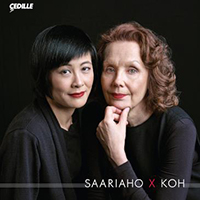Classics Today
By David Vernier
January 21, 2019
original link
Koh Celebrates Saariaho
Artistic Quality: 10
Sound Quality: 10
Imagine the modern performer. In the “old” days, let’s say around the 1950s, the pinnacle for an aspiring young violinist might be the Bach Sonatas and Partitas; the Beethoven sonatas; concertos by Beethoven, Brahms, and Tchaikovsky; perhaps a little Wieniawski, Sarasate, Saint-Saens; Mozart. Yet, today’s most accomplished young performers–more of them than ever before, seemingly born with bow in hand and formidable technique in their DNA–have long ago gobbled up, crunched, and mastered this repertoire–and at younger and younger ages! Bartók you play while you eat your lunch. So what does one do then? Naturally, you look for new material, equally or more challenging.
If you are a performer, you are also a chooser of repertoire. And if you are a thoughtful, practical, intelligent chooser–as is our soloist here, Jennifer Koh–you make your choices not on what you can play, but rather on what draws you, what compels you, what calls you. Koh explains that when she first heard Kaija Saariaho’s music, she knew immediately that this was someone she related to; she “felt like I understood this person.” And so it has been in an ongoing relationship/collaboration between Koh and Saariaho–the composer attended Koh’s recording of these pieces–in which the violinist revels in Saariaho’s brash brushes of color and flagrant flaunting of string technique.
Each of the five works on this program is “about” something. There’s some particular event or scene or impression that inspired their creation. But for me, this is not the most important point. As the composer explains in reference to the origin of her concerto, Graal théâtre, but that I believe should be considered when listening to the entire program, what we hear is about “the theatricality of performance…and the tension between the composition as a fixed score and its realization by a soloist.” Koh has found music that has uniquely challenged and inspired her, and, because she is an exceptional artist, she is giving us something unique and inspired relative to her discovery. Again, she is not playing Beethoven or Mozart because that’s what you do as a violinist; she’s playing something new that has somehow reached deep into her being as an artist. She is like a great theatre actor, delivering a monologue in a manner most intensely personal and riveting, rooted in technique and experience, but making its effect because it’s born of sincere human emotion and an honest affinity for the subject.
No one can honestly describe this music as “beautiful” in the usual sense of the word. But that’s not the point either. Yes, it helps to know that one piece, Tocar, is about “touch”; another, Cloud Trio, was inspired by the changing forms of clouds; yet another, Light & Matter, “draws on the landscape of a city park as it changes with the light”. But we also know that Saariaho uses these ideas only as starting points, perhaps as a general guiding concept; from there, the music is music–abstract yet maintaining a relationship to the original themes of change, of time, of shifting light and sound, or initial conflict of purpose that may or may not resolve in unity.
Although there’s nothing new here in terms of string technique (it’s all been done), Saariaho freely–and effectively–employs the wide range of the violin’s voice; you might say she’s a bit too fond of the sul ponticello, but even so, her use of this device seems purposeful, never gratuitous. Saariaho also infuses these works with unlimited expressive opportunities, as nuanced as any utterances of the human voice.
While listening you always have to pay close attention to the interaction between and among the instruments; something is always being said, some effort being made to communicate something–a question and answer; an exploration of differences (between, say, violin and piano); an observation of movement, of light and color. In the midst of what may seem simply dissonant and unanchored, the violin, Koh’s violin, Koh’s voice, arising from the “tension between score and artistic interpretation”, compels our attention: we want to see what happens. And unlike a Bach sonata or Beethoven concerto (not to take anything away from the genius of those works), we really don’t know what will happen, how it will end. And whether we end up liking the music or not–it’s definitely not easy stuff, we know that Koh has taken us to that end honestly, as true as possible to the composer.
Copyright © Classics Today
© Jennifer Koh, All Rights Reserved. Photography by Juergen Frank. Site by ycArt design studio
